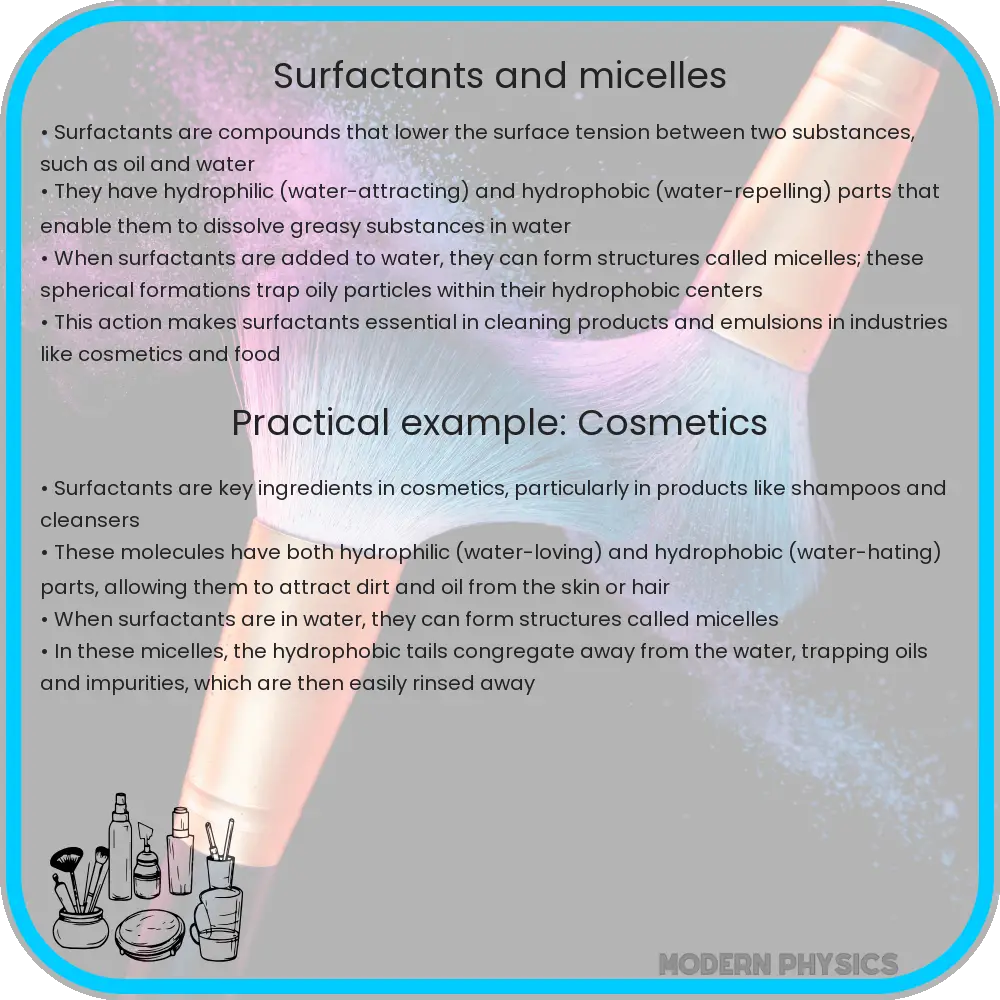Explore the structure, applications, and dynamics of surfactants and micelles, their role in industries, environmental impact, and future directions.

Understanding Surfactants and Micelles
Surfactants, or surface-active agents, are compounds that lower the surface tension between two substances, such as a liquid and a gas, or between a liquid and another liquid. This unique property arises from their amphiphilic structure, meaning they contain both hydrophilic (water-attracting) and hydrophobic (water-repelling) parts. The hydrophilic part, typically a polar group, allows surfactants to dissolve in water, while the hydrophobic part, usually a long hydrocarbon chain, tends to repel water and associate with oils and fats.
Structure and Formation of Micelles
When surfactants are added to water and reach a certain concentration, known as the critical micelle concentration (CMC), they spontaneously form micelles. Micelles are spherical structures where the hydrophobic tails of the surfactant molecules are sequestered away from the water, forming a core, while the hydrophilic heads face outward, interacting with the water. This arrangement reduces the free energy of the system, leading to the spontaneous formation of micelles in solution.
Applications of Surfactants
- Detergents and Cleaning Agents: The ability of surfactants to emulsify oils and fats makes them ideal for use in household and industrial cleaning products.
- Pharmaceuticals: Surfactants are used to enhance the solubility of drugs, making them more effective and easier to administer.
- Food Industry: They are added to food products to improve texture, stability, and shelf-life.
- Cosmetics: In cosmetics, surfactants are used for their emulsifying properties, helping to mix water with oils and fats in products like lotions and shampoos.
Dynamics of Micelles
The formation and behavior of micelles depend on factors such as surfactant concentration, temperature, and the presence of salts or other additives. These factors can influence the size, shape, and stability of micelles, which in turn affect their functionality in different applications. The dynamic nature of micelles allows them to adapt to varying environmental conditions, making surfactants versatile tools in many industries.
Environmental Impact and Sustainability of Surfactants
While surfactants are beneficial in numerous applications, their environmental impact cannot be overlooked. Many conventional surfactants are derived from petroleum and can be persistent in the environment, leading to concerns over bioaccumulation and toxicity. Biodegradable surfactants, often derived from plant or animal sources, have been developed to address these issues. These eco-friendly alternatives are designed to break down more quickly and reduce environmental harm, marking a significant step towards sustainable surfactant technology.
Future Directions in Surfactant Research
The ongoing research in surfactant chemistry focuses on creating more efficient, environmentally friendly, and versatile agents. Innovations include the development of switchable surfactants, which can change their structure in response to environmental triggers, and nanoscale surfactants, which offer unique properties due to their size. These advancements hold the potential to revolutionize industries ranging from medicine to environmental cleanup, highlighting the continued importance of surfactants in scientific and industrial realms.
Conclusion
Surfactants play a crucial role in our daily lives, contributing to various products and processes across multiple industries. Their unique amphiphilic structures allow for the formation of micelles, which are central to the functionality of surfactants in cleaning, pharmaceuticals, food, and cosmetics. As the demand for more sustainable and environmentally friendly products grows, the development of biodegradable and innovative surfactants becomes increasingly important. With ongoing research and technological advancements, the future of surfactants looks promising, offering potential solutions to current environmental challenges and opening new avenues for industrial application and environmental preservation.
